
Home » Transcript Library » All Transcripts » Methods of Testing in Psychology: Observation, Self-Report, and Experimentation Transcript
Methods of Testing in Psychology: Observation, Self-Report, and Experimentation Transcript
Speaker spk_0 00:00:00
He knows a lot about the science stuff, Professor Dave Explains.
Professor Dave 00:00:06
All sciences use the scientific method to understand how something works. Scientists use models to
make predictions, collect data and then see if the data ultimately support their predictions. In the case of
psychology, we are trying to understand how the mind works. Psychologists have come up with a variety
of ways to collect data on the mind in order to test their hypotheses. So let's learn about some of those
now.
00:00:34
First, psychologists will sometimes use case studies to gather information about a phenomenon. In a
case study, psychologists will create a detailed description about a single person or small group of people
that demonstrate rare behaviors. Unlike other methods in psychology, case studies usually do not have a
specific hypothesis attached to them. Instead of direct experimentation, psychologists in a case study are
simply describing how a person is behaving. This means that case studies cannot be used to determine
what actually caused the behavior. They can, however, be used to generate hypotheses that can later be
tested experimentally.
00:01:20
A famous case study is that of Phineas Gage, a railroad construction worker in the 1800s. In 1848,
Gage was clearing rock to lay down new railroad tracks when an unexpected explosion shot a
three foot long piece of iron through his head and damaged the frontal lobe of his brain.
Amazingly, Gage survived the accident and was speaking and walking within a few minutes of the event.
His personality, however, was forever changed. Specifically, he was known to be incredibly aggressive
after the accident. Now, because this is a case study, we don't know exactly what caused this. Was this
personality change due to blood loss, the shock of having iron go through his head, brain damage? There
were too many variables to know for sure. But psychologists did use Phineas Gage's case study to
generate hypotheses about what certain areas of the brain do. For example, because Gage became
much more impulsive and aggressive after his frontal lobe was damaged, psychologists made specific
predictions that the frontal lobe was responsible for executive and emotional functions. They then
experimentally tested this prediction and found that the frontal lobe of the brain is indeed responsible for
controlling emotions and decisions.
00:02:40
Because case studies are rare and we can't use them to determine what is causing behaviors,
psychologists rely on other methods to directly test the mind and gather data. One common method is to
use observation. This method of data collection is pretty straightforward. Psychologists simply sit and
watch what people do in different scenarios. They might sit on a playground and make notes regarding
which kids play in groups versus alone or they might record people standing in a line and make note of
when they decide to leave the line. Observations allow psychologists to get a glimpse of someone's mind
through their behavior.
00:03:21
Another method of data collection is self-report. To gather data, psychologists will give participants
surveys and questionnaires to fill out regarding how they feel or what they are thinking. Self-reports are
easy, inexpensive, and quick, but can also be filled with problems. The participants may fill out a
questionnaire based on what they think the scientist wants to hear, not what they actually feel. They might
also be dishonest with their answers in a variety of ways and for any number of reasons. Finally, neither
self-reporting nor observation can inform us on what is causing a behavior, only what is correlated with it.
Watching kids at a playground or asking them questions after they're done playing doesn't tell us why
they are playing with certain kids and not others, simply that they are.
00:04:09
To directly test predictions and better understand why people do things, psychologists rely on
experimentation. This is the exact same process that other sciences use to test predictions. They will
isolate potential variables affecting a behavior, manipulate one of them, which we call the independent
variable and measure the outcome or the dependent variable. Ideally, participants will be randomly
placed in either the control group, where there is no experimental manipulation, or the experimental
group. When creating a psychological experiment, scientists must first ensure that the experiment is
ethical and there is no lasting emotional or physical harm to participants. They also often have to simplify their experiments so that they are sure they are only testing one variable and that others are not
interfering with the results.
00:05:01
Psychologists may use a variety of tools to measure how the mind works during these experiments. They
could use skin conductance or measure levels of stress hormones in saliva samples to determine
physiological responses to experimental manipulations. Studies looking at attention often use eye
tracking devices to directly measure where and how long people pay attention to different things in front
of them. And psychologists interested in how the brain relates to the mind may measure how brain activity
correlates with thoughts and emotions or even directly stimulate parts of the brain to see what behavior
occurs as a result.
00:05:41
Most psychologists use a mixture of observation, self-report and direct experimentation to test
hypotheses on how the mind works. Correlating all three gives us a better understanding of how what
people think measured with self-report relates to their behavior measured with observation and even
bodily functions such as arousal and brain activity.
00:06:05
Before we move on to some actual psychology, there is one more caveat we must discuss and that is so-
called WEIRD populations in psychology. WEIRD stands for Western, Educated, Industrialized, Rich,
and Democratic. Most psychological studies have a WEIRD bias, which means that their participants are
usually from regions that are WEIRD. Only one eighth of people worldwide live in regions that are
classified as WEIRD, but most studies are performed on these people and the results are then
generalized to the entire world. This is a significant issue, especially since the little research done on non-
WEIRD populations has shown differences in moral decision making, fairness and even visual perception.
00:06:54
As we go through the series, I will point out when a phenomenon has been shown to be different across
cultures. As psychological research continues, more and more studies will be done on non-WEIRD
populations and we will gain a better knowledge regarding what sort of psychology is truly universal. But
for our own purposes, let's move forward and get into some basic concepts in psychology.
00:07:19
Thanks for watching. Subscribe to my channel for more tutorials. Support me on Patreon, so I can keep
making content and as always, feel free to email me, ProfessorDaveExplains@gmail.com.
Copyright Disclaimer
Under Title 17 U.S.C. Section 107, allowance is made for “fair use” for purposes such as criticism, comment, news reporting, teaching, scholarship, and research. Fair use is permitted by copyright statute that might otherwise be infringing.






